Thành viên:Duclongkhanhlinh/nháp
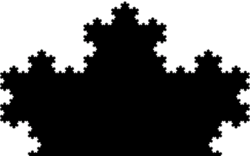

Trong Toán học, một tập hợp hay một đối tượng Tự đồng dạng nghĩa là đối tượng đó tương tự hoặc đồng dạng với chính nó. ( Tức là cái bộ phận đồng dạng, có cùng hình dáng với cái toàn thể ) Có rất nhiều đối tượng trong tự nhiên như đường bờ biển là Tự đồng dạng theo nghĩa rời rạc. Các thành phần có cùng tính chất ở mọi cấp độ phóng đại.[2] Tự đồng dạng là một tính chất có tính điển hình của fractals. Hình dạng bất biến sẽ tạo nên một Tập tự đồng dạng nơi mà khi phóng to đối tượng thì các thành phần nhỏ hơn đồng dạng với cái toàn thể. Ví dụ tại một cạnh của bông tuyết Koch chúng đồng thời đối xứng và bất biến về hình dạng; nó được phóng to một cách liên tục lên 3 lần và hình dạng không hề thay đổi. Những bằng chứng về tính chất của sự đồng dạng không tầm thường ở Fractals được phân biệt bởi cấu trúc rất tốt của nó chi tiết trên các tỷ lệ nhỏ tuỳ ý.
As a counterexample, whereas any portion of a straight line may resemble the whole, further detail is not revealed.
A time developing phenomenon is said to exhibit self-similarity if the numerical value of certain observable quantity measured at different times are different but the corresponding dimensionless quantity at given value of remain invariant. It happens if the quantity exhibits dynamic scaling. The idea is just an extension of the idea of similarity of two triangles.[3][4][5] Note that two triangles are similar if the numerical values of their sides are different however the corresponding dimensionless quantities, such as their angles, coincide.
Peitgen et al. explain the concept as such:
If parts of a figure are small replicas of the whole, then the figure is called self-similar....A figure is strictly self-similar if the figure can be decomposed into parts which are exact replicas of the whole. Any arbitrary part contains an exact replica of the whole figure.[6]
Since mathematically, a fractal may show self-similarity under indefinite magnification, it is impossible to recreate this physically. Peitgen et al. suggest studying self-similarity using approximations:
In order to give an operational meaning to the property of self-similarity, we are necessarily restricted to dealing with finite approximations of the limit figure. This is done using the method which we will call box self-similarity where measurements are made on finite stages of the figure using grids of various sizes.[7]
This vocabulary was introduced by Benoit Mandelbrot in 1964.[8]
Self-affinity
[sửa | sửa mã nguồn]
In mathematics, self-affinity is a feature of a fractal whose pieces are scaled by different amounts in the x- and y-directions. This means that to appreciate the self similarity of these fractal objects, they have to be rescaled using an anisotropic affine transformation.
Definition
[sửa | sửa mã nguồn]A compact topological space X is self-similar if there exists a finite set S indexing a set of non-surjective homeomorphisms for which
If , we call X self-similar if it is the only non-empty subset of Y such that the equation above holds for . We call
a self-similar structure. The homeomorphisms may be iterated, resulting in an iterated function system. The composition of functions creates the algebraic structure of a monoid. When the set S has only two elements, the monoid is known as the dyadic monoid. The dyadic monoid can be visualized as an infinite binary tree; more generally, if the set S has p elements, then the monoid may be represented as a p-adic tree.
The automorphisms of the dyadic monoid is the modular group; the automorphisms can be pictured as hyperbolic rotations of the binary tree.
A more general notion than self-similarity is Self-affinity.
Examples
[sửa | sửa mã nguồn]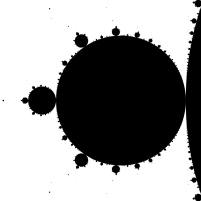
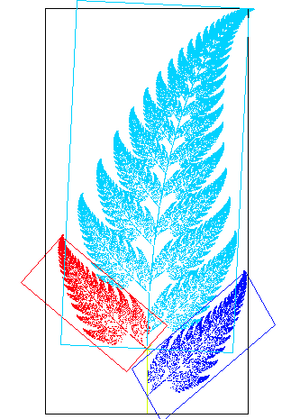
The Mandelbrot set is also self-similar around Misiurewicz points.
Self-similarity has important consequences for the design of computer networks, as typical network traffic has self-similar properties. For example, in teletraffic engineering, packet switched data traffic patterns seem to be statistically self-similar.[9] This property means that simple models using a Poisson distribution are inaccurate, and networks designed without taking self-similarity into account are likely to function in unexpected ways.
Similarly, stock market movements are described as displaying self-affinity, i.e. they appear self-similar when transformed via an appropriate affine transformation for the level of detail being shown.[10] Andrew Lo describes stock market log return self-similarity in econometrics.[11]
Finite subdivision rules are a powerful technique for building self-similar sets, including the Cantor set and the Sierpinski triangle.
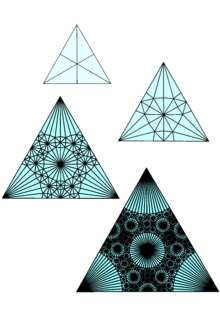
In cybernetics
[sửa | sửa mã nguồn]The viable system model of Stafford Beer is an organizational model with an affine self-similar hierarchy, where a given viable system is one element of the System One of a viable system one recursive level higher up, and for whom the elements of its System One are viable systems one recursive level lower down.
In nature
[sửa | sửa mã nguồn]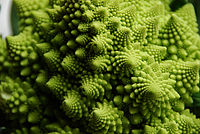
Self-similarity can be found in nature, as well. To the right is a mathematically generated, perfectly self-similar image of a fern, which bears a marked resemblance to natural ferns. Other plants, such as Romanesco broccoli, exhibit strong self-similarity.
In music
[sửa | sửa mã nguồn]- Strict canons display various types and amounts of self-similarity, as do sections of fugues.
- A Shepard tone is self-similar in the frequency or wavelength domains.
- The Danish composer Per Nørgård has made use of a self-similar integer sequence named the 'infinity series' in much of his music.
- In the research field of music information retrieval, self-similarity commonly refers to the fact that music often consists of parts that are repeated in time.[12] In other words, music is self-similar under temporal translation, rather than (or in addition to) under scaling.[13]
See also
[sửa | sửa mã nguồn]References
[sửa | sửa mã nguồn]- ^ Mandelbrot, Benoit B. (1982). The Fractal Geometry of Nature, p.44. ISBN 978-0716711865.
- ^ Mandelbrot, Benoit B. (5 tháng 5 năm 1967). “How long is the coast of Britain? Statistical self-similarity and fractional dimension”. Science. New Series. 156 (3775): 636–638. Bibcode:1967Sci...156..636M. doi:10.1126/science.156.3775.636. PMID 17837158. S2CID 15662830. PDF
- ^ Hassan M. K., Hassan M. Z., Pavel N. I. (2011). “Dynamic scaling, data-collapseand Self-similarity in Barabasi-Albert networks”. J. Phys. A: Math. Theor. 44 (17): 175101. arXiv:1101.4730. Bibcode:2011JPhA...44q5101K. doi:10.1088/1751-8113/44/17/175101. S2CID 15700641.Quản lý CS1: nhiều tên: danh sách tác giả (liên kết)
- ^ Hassan M. K., Hassan M. Z. (2009). “Emergence of fractal behavior in condensation-driven aggregation”. Phys. Rev. E. 79 (2): 021406. arXiv:0901.2761. Bibcode:2009PhRvE..79b1406H. doi:10.1103/physreve.79.021406. PMID 19391746. S2CID 26023004.
- ^ Dayeen F. R., Hassan M. K. (2016). “Multi-multifractality, dynamic scaling and neighbourhood statistics in weighted planar stochastic lattice”. Chaos, Solitons & Fractals. 91: 228. arXiv:1409.7928. Bibcode:2016CSF....91..228D. doi:10.1016/j.chaos.2016.06.006.
- ^ Peitgen, Heinz-Otto; Jürgens, Hartmut; Saupe, Dietmar; Maletsky, Evan; Perciante, Terry; and Yunker, Lee (1991). Fractals for the Classroom: Strategic Activities Volume One, p.21. Springer-Verlag, New York. ISBN 0-387-97346-X and ISBN 3-540-97346-X.
- ^ Peitgen, et al (1991), p.2-3.
- ^ Comment j'ai découvert les fractales, Interview de Benoit Mandelbrot, La Recherche https://www.larecherche.fr/math%C3%A9matiques-histoire-des-sciences/%C2%AB-comment-jai-d%C3%A9couvert-les-fractales-%C2%BB
- ^ Leland, W.E.; Taqqu, M.S.; và đồng nghiệp (tháng 1 năm 1995). “On the self-similar nature of Ethernet traffic (extended version)” (PDF). IEEE/ACM Transactions on Networking. 2 (1): 1–15. doi:10.1109/90.282603. S2CID 6011907.
- ^ Benoit Mandelbrot (tháng 2 năm 1999). “How Fractals Can Explain What's Wrong with Wall Street”. Scientific American.
- ^ Campbell, Lo and MacKinlay (1991) "Econometrics of Financial Markets ", Princeton University Press! ISBN 978-0691043012
- ^ Foote, Jonathan (30 tháng 10 năm 1999). “Visualizing music and audio using self-similarity”. Proceedings of the seventh ACM international conference on Multimedia (Part 1) - MULTIMEDIA '99 (PDF). Multimedia '99 Proceedings of the Seventh ACM International Conference on Multimedia (Part 1). tr. 77–80. CiteSeerX 10.1.1.223.194. doi:10.1145/319463.319472. ISBN 978-1581131512. S2CID 3329298. Lưu trữ (PDF) bản gốc 9 Tháng tám năm 2017.
- ^ Pareyon, Gabriel (tháng 4 năm 2011). On Musical Self-Similarity: Intersemiosis as Synecdoche and Analogy (PDF). International Semiotics Institute at Imatra; Semiotic Society of Finland. tr. 240. ISBN 978-952-5431-32-2. Bản gốc (PDF) lưu trữ 8 Tháng hai năm 2017. Truy cập 30 tháng Bảy năm 2018. (Also see Google Books)
External links
[sửa | sửa mã nguồn]- "Copperplate Chevrons" — a self-similar fractal zoom movie
- "Self-Similarity" — New articles about Self-Similarity. Waltz Algorithm
Self-affinity
[sửa | sửa mã nguồn]- Mandelbrot, Benoit B. (1985). “Self-affinity and fractal dimension” (PDF). Physica Scripta. 32 (4): 257–260. Bibcode:1985PhyS...32..257M. doi:10.1088/0031-8949/32/4/001.
- Sapozhnikov, Victor; Foufoula-Georgiou, Efi (tháng 5 năm 1996). “Self-Affinity in Braided Rivers” (PDF). Water Resources Research. 32 (5): 1429–1439. doi:10.1029/96wr00490. Lưu trữ (PDF) bản gốc 30 tháng Bảy năm 2018. Truy cập 30 tháng Bảy năm 2018.
- Benoît B. Mandelbrot (2002). Gaussian Self-Affinity and Fractals: Globality, the Earth, 1/F Noise, and R/S. ISBN 978-0387989938.






